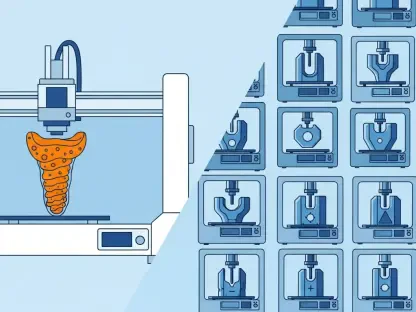In a world where the pharmaceutical industry is valued at over $1.7 trillion and projected to soar past $2.3 trillion by 2030, the race to innovate has never been more intense or consequential. This sector, a cornerstone of global health and economic vitality, thrives on the ability to transform groundbreaking ideas into life-saving therapies. Yet, beneath the surface of blockbuster drugs and towering corporate giants lies a critical, often underappreciated force: intellectual property (IP) protection. Far from being a mere legal formality, IP serves as the bedrock that secures innovation, fosters competition, and drives long-term growth. From multinational corporations to agile start-ups, companies depend on robust IP strategies to safeguard their discoveries in an environment where a single breakthrough can redefine markets. This exploration delves into the pivotal role of IP in propelling the pharmaceutical landscape forward, highlighting its impact on both industry giants and the smaller innovators shaping the future of healthcare.
The Role of IP in Industry Growth
Driving Innovation Through Protection
The pharmaceutical sector is undergoing a transformative shift, propelled by demographic changes and technological advancements that demand constant innovation. An aging global population, coupled with the increasing prevalence of chronic diseases, has intensified the need for novel drugs and therapies tailored to specific patient needs. Simultaneously, the rise of personalized medicine seeks to customize treatments based on individual genetic profiles, pushing the boundaries of traditional healthcare. Technologies such as artificial intelligence (AI) and genomics are revolutionizing the speed and precision of drug discovery, enabling researchers to identify potential treatments faster than ever before. However, these advancements also heighten the risk of replication by competitors, making IP protection indispensable. By securing patents and other IP rights, companies can shield their innovations from unauthorized use, ensuring they retain the competitive edge needed to justify the immense resources poured into research. Without such safeguards, the incentive to push scientific boundaries could wane, slowing the pace of medical progress.
Beyond the immediate protection of new therapies, IP serves as a catalyst for collaboration and knowledge-sharing within the industry. When companies feel confident that their intellectual assets are secure, they are more likely to engage in partnerships, licensing agreements, and joint ventures that can accelerate drug development. This is particularly vital in fields like genomics, where complex data sets and proprietary algorithms often underpin breakthroughs. IP frameworks provide a structured environment where innovators can share insights without fear of losing control over their core ideas. Moreover, protected IP encourages investment in high-risk, high-reward projects, as stakeholders know their contributions are safeguarded against exploitation. This dynamic is evident in the surge of start-ups entering the personalized medicine space, where IP not only protects their novel approaches but also positions them as attractive partners for larger firms. In this way, IP becomes a bridge between individual innovation and broader industry advancement, fostering an ecosystem of continuous improvement.
Financial Backbone of Pharmaceuticals
The financial landscape of pharmaceuticals is staggering, with over $288 billion invested in research and development (R&D) in the past year alone, marking it as one of the most heavily funded sectors globally. High-profile drugs like Ozempic, which generates over $16 billion annually, exemplify the immense profitability that successful innovations can achieve. These figures underscore the high stakes involved, where a single drug can transform a company’s fortunes. IP protection plays a central role in this equation by ensuring that the enormous costs of R&D are recouped through exclusive rights to market and sell the resulting products. For large corporations, patents provide a window of exclusivity to dominate markets, while for smaller entities, they represent a critical asset that can be leveraged during funding rounds or acquisitions. Without IP, the financial incentive to undertake costly, years-long development processes would diminish, potentially stalling the pipeline of new treatments.
Equally important is the role of IP in sustaining the vibrant start-up ecosystem that drives much of the industry’s innovation. In the last year, over $26 billion was funneled into drug discovery start-ups, reflecting a growing recognition of their potential to deliver the next generation of therapies. For these smaller players, IP is often their most valuable asset, distinguishing them in a crowded market and providing a tangible measure of their worth to investors. A strong IP portfolio can mean the difference between securing a multimillion-dollar investment and fading into obscurity. Furthermore, IP protection mitigates the risk of larger competitors replicating a start-up’s work without compensation, preserving the smaller company’s ability to compete or negotiate favorable terms in partnerships. This financial security, rooted in IP, enables start-ups to focus on pushing scientific boundaries rather than constantly guarding against theft, ultimately benefiting the entire industry through a steady flow of fresh ideas.
Challenges for Start-Ups and Scale-Ups
Financial Fragility and Strategic Timing
Start-ups and scale-ups in the pharmaceutical sector operate in an environment of extraordinary financial pressure, where the high “burn rate”—the rapid expenditure of capital on research, trials, and regulatory processes—poses a constant threat to their survival. Unlike established giants with deep reserves, these smaller entities often lack the resources to weather prolonged development cycles, making every dollar spent a calculated risk. Many must seek acquisition by larger firms to bring their innovations to market, a process where IP emerges as their primary bargaining chip. A robust IP portfolio can significantly boost valuation, ensuring fair compensation for years of effort. However, the timing of such exits is a delicate balancing act. Exiting too early may undervalue the innovation, while delaying too long risks financial collapse, leaving IP unprotected and accessible to competitors. This fragility highlights why strategic IP management is not just beneficial but essential for smaller players navigating this high-stakes terrain.
The vulnerability of start-ups is compounded by the sheer complexity of drug development, where failures in clinical trials or regulatory hurdles can drain resources overnight. In such scenarios, IP serves as a safety net, preserving the core value of their work even if immediate commercialization isn’t achievable. For instance, a well-protected innovation can still attract interest from potential acquirers or licensing partners, offering a lifeline when internal funding runs dry. This protective layer allows start-ups to take calculated risks on bold ideas without the constant fear of losing everything to a better-resourced rival. Additionally, IP can act as a signal of credibility to investors, demonstrating that the company has taken steps to secure its future. The challenge lies in balancing the cost of IP protection with limited budgets, a task that often requires expert guidance to prioritize filings and avoid overextension. In this precarious landscape, IP becomes both a shield and a strategic tool for survival.
Strategic IP Management
Start-ups and scale-ups must adopt a forward-thinking approach to IP that goes beyond securing a single patent for a drug compound. A comprehensive portfolio, encompassing the drug’s formulation, delivery mechanisms, and dosage forms, offers broader protection and enhances a company’s market position. Such a strategy not only deters competitors from encroaching on key innovations but also increases appeal to investors and potential acquirers. Real-world examples, like Inflazome’s $449 million acquisition by Roche or Tagomics securing $6.7 million in funding, illustrate how a well-rounded IP portfolio can translate into significant commercial success. These cases demonstrate that protecting multiple facets of an innovation creates a stronger barrier against imitation and positions the company as a valuable asset in negotiations. For smaller players, this holistic approach can be the difference between fading into obscurity and achieving a transformative deal that propels their work to global markets.
Implementing strategic IP management also requires aligning legal protections with business goals, a process that can be daunting for resource-constrained start-ups. Partnering with experienced IP advisors can alleviate this burden, allowing companies to focus on scientific advancement while ensuring their assets are safeguarded. Such partnerships often involve identifying patentable elements early, conducting competitor analyses to avoid overlaps, and preparing for due diligence during acquisition talks. This proactive stance helps smaller firms navigate the complex interplay of innovation and commerce, maximizing the value of their IP at every stage. Moreover, a robust portfolio can serve as a deterrent to litigation, as competitors are less likely to challenge a well-protected entity. By viewing IP as a core component of their business strategy rather than an afterthought, start-ups and scale-ups can build resilience against the inherent uncertainties of drug development, paving the way for sustainable growth.
Navigating Complex IP Landscapes
Technology and Competition
The rapid integration of cutting-edge technologies like AI and genomics into pharmaceutical research has dramatically accelerated drug discovery, but it has also intensified the complexity of IP landscapes. These tools enable unprecedented precision in identifying therapeutic targets, yet they generate vast amounts of proprietary data and algorithms that require protection. As technical fields become increasingly crowded, distinguishing a novel innovation from existing patents demands sophisticated IP strategies. Companies must navigate intricate webs of prior art and overlapping claims to secure their place in the market. Without robust IP protection, the risk of competitors replicating or building upon unprotected advancements grows, potentially undermining years of research. This environment underscores the necessity of tailored IP approaches that account for the unique challenges posed by technology-driven innovation, ensuring that companies can capitalize on their discoveries without fear of exploitation.
Equally critical is the competitive pressure that technology amplifies within the industry, where speed to market can determine success or failure. As digital health solutions and AI-driven platforms become integral to drug development, the lines between software, data, and traditional pharmaceutical IP blur, creating new battlegrounds for protection. Companies must anticipate how rivals might leverage similar technologies and proactively secure their intellectual assets to maintain an edge. This often involves filing patents not just for the end product but for the underlying processes and tools that enable innovation. Additionally, the global nature of competition means that IP strategies must account for varying regulations across jurisdictions, adding another layer of complexity. By staying ahead of these trends and adopting comprehensive protection measures, pharmaceutical entities can safeguard their contributions to a rapidly evolving field, ensuring that technological progress translates into tangible, protected value.
Shaping Future Success Through IP
Reflecting on the journey of pharmaceutical innovation, it’s evident that IP protection stands as a steadfast guardian against the vulnerabilities that once threatened countless start-ups and scale-ups. The industry’s past achievements, bolstered by over $288 billion in R&D investments in recent years, were often secured through strategic patents and portfolios that shielded groundbreaking therapies from replication. Smaller players, despite their financial fragility, found strength in IP as their most reliable asset during acquisitions or funding rounds, as seen in landmark deals like Inflazome’s $449 million exit. The collaborative efforts between innovators and IP experts frequently paved the way for success, turning complex legal landscapes into opportunities for growth. Looking ahead, the path forward demands that companies continue to prioritize IP as a core business strategy, integrating it into every stage of development. Partnering with specialized advisors to navigate emerging challenges, particularly in technology-driven fields, will be crucial. By embracing these steps, the pharmaceutical sector can ensure that the spirit of innovation remains vibrant, driving health solutions for generations to come.









